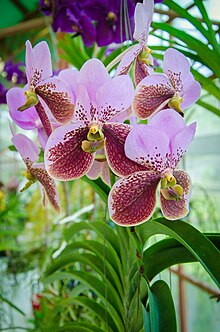
Vanda, abbreviated in the horticultural trade as V., is a genus in the orchid family, Orchidaceae. There are 90 species, and the genus is commonly cultivated for the marketplace. This genus and its allies are considered to be among the most specifically adapted of all orchids within the Orchidaceae. The genus is highly prized in horticulture for its showy, fragrant, long-lasting, and intensely colorful flowers. Vanda species are widespread across East Asia, Southeast Asia, and New Guinea, with a few species extending into Queensland and some of the islands of the western Pacific.
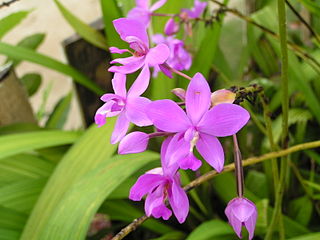
Spathoglottis, commonly known as purple orchids or 苞舌兰属 is a genus of about fifty species of orchids in the family Orchidaceae. They are evergreen terrestrial herbs with crowded pseudobulbs, a small number of leaves and medium-sized resupinate flowers on an upright flowering stem. The sepals and petals are all similar to each other and are white, yellow, pink or purple. Species of Spathoglottis are found from eastern and south-eastern Asia to Australia and some Pacific Islands.

Miltonia, abbreviated Milt. in the horticultural trade, is an orchid genus comprising twelve epiphyte species and eight natural hybrids. The miltonias are exclusively inhabitants of Brazil, except for one species whose range extends from Brazil into the northeast of Argentina and the east of Paraguay.

Paphinia lindeniana is a species of orchid native to Colombia, Venezuela, Brazil, Peru and possibly Guyana.

Aphyllorchis, commonly known as pauper orchids or as 無葉蘭屬/无叶兰属 , is a genus of about twenty species of terrestrial leafless orchids in the family Orchidaceae. Orchids in this genus have fleshy, upright stems and small to medium-sized resupinate flowers with narrow sepals and petals. They are native to a region extending from India east to China and Japan, south to Indonesia, New Guinea and Queensland.

Trichoglottis, commonly known as cherub orchids or 毛舌兰属 , is a genus of flowering plants in the family Orchidaceae. Orchids in this genus are epiphytic plants with thick roots, relatively thick, fibrous stems and many large, thick, leathery leaves arranged in two ranks. The flowers are usually small and yellowish with light brown or purple markings. The flowers have broad sepals, narrower petals and a labellum which has three lobes and is often hairy. There are about 85 species distributed from tropical and subtropical Asia to the north-western Pacific. Most species grow in rainforest.
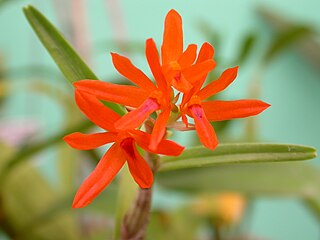
Scaphyglottis is a genus of orchids native to Mexico, Central America, northern South America and parts of the Caribbean. The current concept of this genus is the result of combining several genera which have been described at various times. The concept is characterized by the growth habit: not only are new pseudobulbs added at the base of the old ones, but new pseudobulbs also grow at the apices of the old ones. Many species are quite similar and difficult to distinguish, but some are clearly distinct. A few have showy colors. The genus comprises nearly 70 species.
The national symbols of the Philippines consist of symbols that represent Philippine traditions and ideals and convey the principles of sovereignty and national solidarity of the Filipino people. Some of these symbols namely the national flag, the Great Seal, the coat of arms and the national motto are stated in the Flag and Heraldic Code of the Philippines, which is also known as Republic Act 8491. In the Constitution of the Philippines, the Filipino language is stated as the national language of the Philippines. Aside from those stated symbols in the Constitution and in Republic Act 8491, there are only six official national symbols of the Philippines enacted through law, namely sampaguita as national flower, narra as national tree, the Philippine eagle as national bird, Philippine pearl as national gem, arnis as national martial art and sport and the Filipino Sign Language as the national sign language. Thus, there is a total of twelve official national symbols passed through Philippine laws.

Aerangis fastuosa, commonly known as the 'magnificent Aerangis', is a species of epiphytic orchid endemic to Madagascar. It is widespread across Madagascar, stretching from the eastern coastal forests across to the south and along the central plateau. Aerangis fastuosa belongs to the family Orchidaceae, subtribe Aerangidinae.
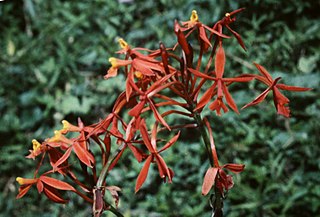
Epidendrum macrocarpum, widely known as Epidendrum schomburgkii, is a species of orchid in the genus Epidendrum, and the largest-flowering crucifix orchid species. Reichenbach thought that E. fulgens and E. schomburgkii var. confluens were both synonyms for this species.

Epidendrum microphyllum is a species of tropical orchid in the genus Epidendrum with non-resupinate flowers.

Dendrobium discolor, commonly known as antler orchid or golden orchid, is a species of epiphytic or lithophytic orchid in the family Orchidaceae, and are native to northern Australia, New Guinea, and part of Indonesia. It has cylindrical pseudobulbs, each with between ten and thirty five leathery leaves, and flowering stems with up to forty mostly brownish or greenish flowers with wavy and twisted sepals and petals.

Vanda cristata is a species of orchid found growing in the Himalaya from Bangladesh, India, Nepal, Bhutan to China at elevations of 600 – 2300 meters.

Papilionanthe Miss Joaquim, also known as the Singapore orchid, the Princess Aloha orchid, and commonly known by its original name Vanda Miss Joaquim, is a hybrid orchid that is the national flower of Singapore. For its resilience and year-round blooming quality, it was chosen on 15 April 1981 to represent Singapore's uniqueness and hybrid culture. This orchid is the first registered plant hybrid from Singapore.

Dendrobium trilamellatum, commonly known as the fragrant tea tree orchid or large tea tree orchid, is a species of epiphytic orchid found in northern Australia and New Guinea. It has spindle-shaped pseudobulbs, between three and seven leathery, dark green leaves and between three and fifteen yellow, yellowish brown or brown flowers with a mauve to purple labellum.
Epidendrum alpicola is a tropical orchid native to Bolivia, Colombia, Ecuador, Peru, and Venezuela at altitudes from 1.8—2.7 km.

Ericksonella saccharata, commonly known as sugar orchid, is the only species in the genus Ericksonella in the orchid family, Orchidaceae, and is endemic to the south-west of Western Australia. It has a single leaf and a single flower with three white sepals and two similar petals.

Koellensteinia is a genus of flowering plants from the orchid family, Orchidaceae. It is named by Heinrich Gustav Reichenbach for the Captain Carl Kellner von Koellenstein, an Austrian military officer and a botanical correspondent of Reichenbach.
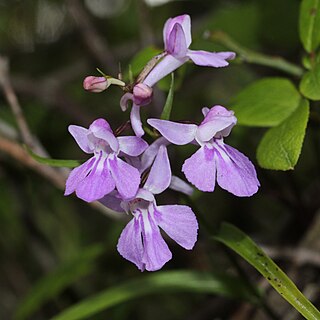
Hemipilia graminifolia is a species of flowering plant in the family Orchidaceae, native to southern Korea and Japan. It is a short herbaceous perennial, growing from a tuber, with small flowers in shades of pink to purple. Many varieties and cultivars are grown in Japan as ornamental plants.

Phaius tankervilleaevar.bernaysii, also known as the yellow swamp orchid, is a species of orchid endemic to a small area of Queensland. It is an evergreen, terrestrial herb with large, crowded pseudobulbs, large pleated leaves and flowers that are white on the outside and sulfur yellow inside. Apart from flower colour, the species is identical to P. tankervilleae var. bernaysii.
